AudioQuest NightHawk
published: Mar-03-2016, updated: Jul-11-2021
NO SMOOTHING is applied to the shown plots. Most measurement sites have some smoothing applied which ‘irons flat’ sharp peaks and ‘wiggles’. I do not use smoothing because some info about sound quality is lost when plots are smoothed.
Aside from a small correction of the microphone itself also some correction in the lowest frequencies is applied to the plots to compensate for the perceived loss of bass when using headphones. This is described HERE in more detail.
A ‘horizontal‘ frequency response curve on the shown frequency response plots on this website thus indicates a perceived ‘flat’ tonal signature.
ALL measurements are made with a good SEAL on a flatbed measurement rig.
The shape of your head, bone structure, pad size, pad ‘softness, (compliance), hair or no hair and or wearing glasses may (drastically) change the frequency response of some headphones, so… your personal experience may differ substantially from these plots.
Frequency response (tonal balance) is the most sound-determining aspect of headphones. A horizontal line shows audible neutral response in the plots on this website. Deviations in different severities at different frequency bands have an effect on the sound character.
The bigger the deviation the stronger the effect.
Below an aid to help determining the sound character of headphones with relation to the frequency response.

AudioQuest NightHawk

The AudioQuest NightHawk is a controversial headphone. A lot has been written about it’s cups, drivers and enclosure. The driver is supposed to be AudioQuest’s own development.
I suspect the driver is made by Foster, maybe made exclusively for AQ. The split gap motor (common in speakers) and the ‘frame holes’ that go all the way around the magnet seems not to be present in other Foster drivers (Fostex, Creative & Denon). The cone material and construction is very ‘Foster’ though.
With a quite low 25 Ohm (same as Denon/Fostex headphones) the NH can easily be driven from portable equipment. The impedance plot is quite flat (well damped mechanically) so a higher output resistance of an amplifier has little influence aside for the usual attenuation.
Comfort is quite high, normal clamping force, maybe even a bit too light in clamping force. All of the clamping force comes from the thin metal rod headband. When you ‘tap’ the headband this is quite audible but well damped.
The cable connects with 2 TS (mono) 2.5mm connectors, 1 to each cup. They come out quite easily which is handy when the (long) cable is yanked on by accident.
The leather pads feel pleasant and leave enough room for my ears.
The first impression one gets is ‘dark/muddy/closed-in’ and ‘soft’ in the treble. As if listening to speakers off axis in the corner of a room with background music.
It’s not that things are obviously ‘missing’ except that it doesn’t sound ‘right’.
The sound is rather ‘easy’ to get used to though.
A lot of headphones sound good or ‘poor’ from the start. Some headphones sound ‘poor’ but you adjust to the colouration and that colouration is not that objectionable after a while.
With some headphones colouration becomes obvious after a while and keeps ‘messing up’ the sound. With other headphones the colouration is agree-able UNTIL you compare it directly to more ‘neutral’ headphones.
To me the colouration stays but becomes less objectionable after time but doesn’t disappear.
The stereo image is quite narrow, almost as if crossfeed is applied. Think the exact opposite effect of the HD800.
Where the HD800 is ‘wide’, highly detailed, trebly and not ‘warm/lush’ (with most recordings) the NightHawk is ‘narrow’, subdued and warm/lush.
Some ‘attack’ is still there but never ‘harsh’ or overly present. Cymbals etc lack ‘energy’, sparkle and presence. They are present but soft and subdued, in the background.
specifications:
Type: Over ear, open
Usage: Home, studio
Driver type: dynamic
Pads: replaceable, leather. Other pads are available
Collapsible: No
Headphone cup connector: 2.5mm TS jack
Cable entry: dual sided
Cable: 1.3m terminated in a 3.5mm TRS jack with a 6.3mm adapter
Driver size: 50mm
Inner Pad dimensions: depth = 20mm, Width = 54mm, height = 60mm, egg shaped
Max. power rating: 1.5W
Max. voltage: 6Vrms (17Vpp)
Max. current: 240mA
Max. S.P.L.: 128 dB
Impedance: 25 Ω
Efficiency: 90dB @ 1mW (1kHz), 99dB@ 1mW (300Hz)
Sensitivity: 106dB @ 1V (1kHz), 115dB @ 1V (300Hz)
Weight: 346 g. (excl. cable)
Clamping force: low/medium
measurements
Below the frequency response of the NightHawk, left, right.
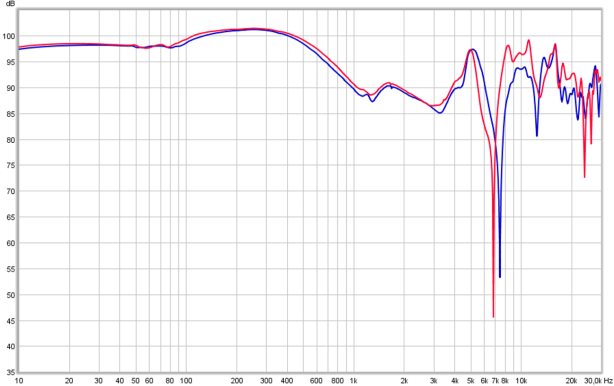
What’s obvious is that the ‘honky/muddy’ sound is also quite visible in the FR.
The elevated 100Hz – 500Hz region is responsible for this. The lift is just a few dB though and does have a ‘smooth’ (as in not jagged) flow. This makes it audible but not as objectionable.
The subdued 1-4kHz region ensures the sound is ‘smooth’ and never becomes ‘harsh’ or shrill. The raised part above 3kHz gives the sound the appearance of still having enough ‘detail’ in the mids. Think guitar and snares/drums.
The sharp ‘dips’ around 7kHz and 7.5kHz aren’t there (audible) in real world situations, a measurement artefact.
The treble extension is much better than one would expect from listening to it. It goes right up there to 30kHz. Still the sound ‘lacks’ air and ‘separation’. This isn’t caused by the driver it seems (it goes up high and is fast enough) but the 100Hz-500Hz region simply ‘overpowers’ those audible cues.
Depending on how ones head is shaped (bone structure etc) it is possible to get a poor seal. When the pads do not seal well there is an immediate (sub)bass loss and the ‘honky’ character is even worse.
Perfect seal, with reading glasses, seal on the bottom side broken.

A good seal is thus important for this headphone.

The 2nd harmonic distortion is relatively high but the higher harmonics are below the thresholds of my test equipment. 2nd harmonic distortion in the lower frequency range isn’t very objectionable as all instruments also have high amounts of harmonics themselves. The THD (near 100dB SPL) is > 47dB
Below the CSD of the NightHawk, left and Right are superimposed
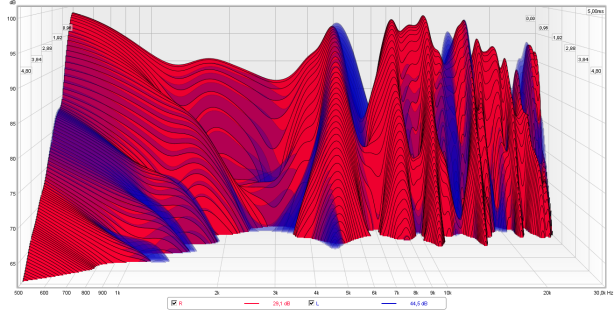
The CSD shows some ringing around 5kHz. Above 8kHz there is some other narrow resonances as well. At lower frequencies the membrane stops quickly. It is just the increase in amplitude that is the culprit for the tonal imbalance, not a resonance.
The Spectrum plots below shows some issues around 1.5kHz. Below 400Hz there is still some ‘energy’ that isn’t absorbed that quickly .
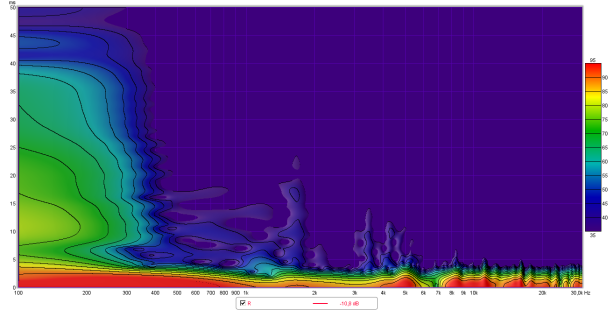
The square-wave response plots below show the stronger and weaker points of this headphone quite clearly. Aside from the ‘400Hz overshoot’ in the 40Hz square-wave the response there is exemplary. Excellent subbass extension.
The 440Hz square-wave looks more like a 5ooHz sine-wave with some 5kHz ringing on it (triggered by the rising edges). Yes it does the midrange quite well. it’s the upper midrange where it drops the ball.
Also the 100us pulse (half of a 5kHz square-wave) shows one of the flaws.
The rising edge is nice and fast and 30kHz is about equally loud as 5kHz.
BUT …. it doesn’t come near the ‘required’ level. On top of that there is quite some ringing following the pulse. A short ‘pulse’ which our brains would like to use to determine the ‘location’ of the sound thus is too low in amplitude and because it is ringing also ‘smears’ that energy over time costing resolution.
Thus the NightHawk has good bass (though a bit on the fat side, the overshoot) mids that are clearly audible but lack ‘clarity and detail’ and treble that is too soft and lacks accuracy because there is too much ringing.
It is said these sound ‘speaker-like’ .. well if your speakers sound like this it is time to look for better ones or seriously look at improving the room or position of the speakers.

In the headphone scene some people have found that the bassy character can be lowered by using other pads.
Below the right channel of the NightHawk with stock pads and with HM5 velours pads.
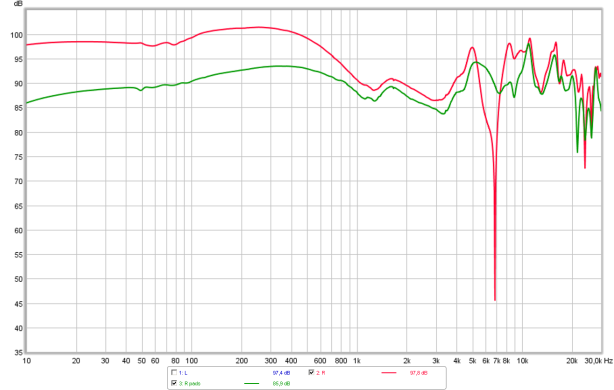
The efficiency is lowered by almost 10dB for the frequency range between 10Hz and 1kHz.
Sub bass extension is still there, but a good 10dB less. Unfortunately the +5dB peak around 300Hz is still there giving the sound a ‘hollowish’ character. because the bass levels do not mask the treble the clarity has improved. The stereo image only has become slightly less narrow. The 5kHz peak/resonance is still there which lowers the resolution. So more treble and clarity but not so much improvement in the ‘detail retrieval’ area.
It lacks resolution and ‘air’ as well as ‘placement’ of instruments where the FR doesn’t give that impression (a bit like the Aureol Teufel).
While the HM5 pads ‘remove’ the excessive warmth (compared to other headphones) and is more agree-able from the moment you put it on the narrow soundstage and ‘elevated’ treble don’t do much good for the overall sound.
It looks like the subdued treble is an effective way of hiding some shortcomings in the ‘detail’ area.
The treble energy can be reduced by adding toilet paper over the driver. This reduces the 5kHz peak slightly but is most effective from 7kHz to 15kHz where the reduction is quite noticeable. HM5 velours pads, added 1 ply of toilet paper, 2 plies of toilet paper.

Unfortunately with the extra treble energy the little detail it had is also removed.
You can’t win them all.
A Kameleon filter will not be constructed. The reason for this is that when the 400Hz hump is lowered the relatively poor treble resolution/quality becomes more accentuated which doesn’t do the headphone any good.
The ‘dark’ character masks the treble issues this headphone has.
With EQ some improvements can be had but a stellar quality it won’t reach.
Do I think the headphone is worth € 600 ?
The answer is no, there are better headphones in this price range.
cables … do they differ ?
Of course AudioQuest is a cable company and along with the NightHawk come 2 cables.
They have the same length but the thickness differs and the connectors differ.
The thinner one (on the left) is the ‘lower’ quality one and is equipped with gold plated connectors.
The thicker one (on the right) is the ‘higher-end’ cable this headphone ‘deserves’ (according to AudioQuest). It has silver plated connectors.
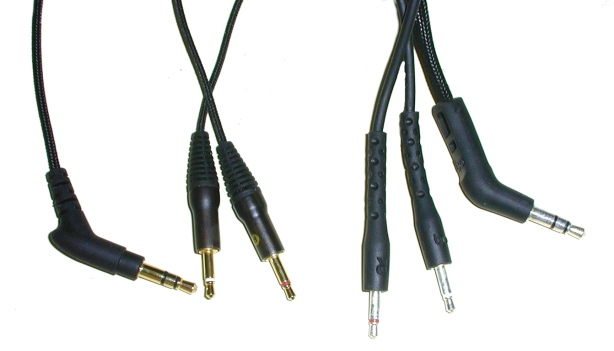
The owner of this headphone reported hearing differences between these cables and wondered if measurable differences could be found.
It is not a secret that I do not believe in the cable business nonsense so expected to see little to no meaningful differences.
Measuring cable differences is not easy because when you unplug cable 1 and insert cable 2 the headphone moves a bit which can have a substantial influence in the frequency range above 5kHz.
So I measured every cable alternately 5 times.
Up to 4 kHz every measurement was an exact copy (except around 50Hz which is a small hum problem) but above 4kHz some differences were found.
I selected the best matching plots (which was the second attempt for both cables) and made the plots from these measurements.
Below the frequency response in a logarithmic frequency scale (the usual scale) but the vertical scale is 2dB/div instead of the usual 5dB/div.
Silver cable, Gold cable (Right channel only)

The higher frequencies are not so easy to see so below the exact same plot BUT with a linear frequency scale.
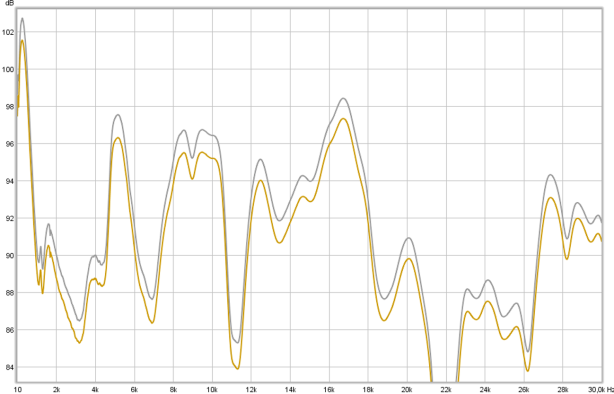
There are some small differences in amplitude but these are caused by the headphone NOT being in the exact same position.
How fast and accurate can you change the cable and get the exact same position afterwards when doing cable swaps ?
Overall it is easy to see that the silver cable is about 1dB louder. It is also obvious that the silver cable does NOT have a higher amplitude for higher frequencies.
The amplitude difference is the same for high and low frequencies so NO difference in tonal balance BUT there is an amplitude difference of 1dB (Measured 1.2dB) which IS audible. Not as an increase in loudness but generally a level increase in this magnitude is perceived as ‘fuller’ sounding.
Below the THD of the silver cable.

Below the THD of the gold cable:
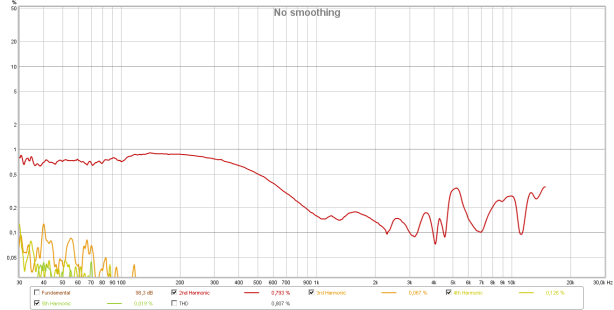
What’s obvious is the relatively high 2nd order distortion which gives the sense of a ‘warmer’ sound. What’s also obvious is that the silver cable shows a slightly higher distortion. This seems odd but isn’t. The silver cable has less attenuation (Ohms law) and thus plays 1dB louder so the distortion is also 1dB higher and this is what the plots show.
When the silver cable were to be measured 1 dB lower in amplitude the distortion would have been exactly the same.
Also the CSD of both cables to see if ‘damping’ differs.
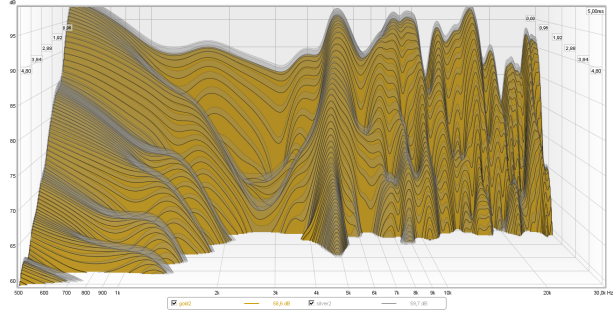
Nope silver and gold CSD is exactly the same BUT the silver one is 1dB higher in initial amplitude. The behaviour is the same.
So it looks like the tonal balance, distortion and impulse response do NOT change with the cable. The silver one is just ‘louder’ which can certainly give the impression it sounds ‘better’ due to the slight level increase.
A cable has 3 basic properties which in reality are a bit more complex but to keep it simple the measurements are split in resistance, capacitance and inductance.
The capacitance of both cables do not differ substantially.
Gold cable is 341pF between L and common, 356pF between R and common and 306pF between L and R.
Silver cable is 392pF between L and common, 397pF between R and common and 218pF between L and R.
The biggest difference between these cables is the L to R capacitance which is lower in the expensive cable. Does this matter ?
Well the R load (assuming the voice coil isn’t a coil) is around 30Ω then the -3dB frequency of the capacitive coupling for the cheaper cable is 17MHz … I can’t hear that high up but assuming 10kHz is quite audible we need we can calculate how much ‘resistance’ that capacitance has. At 306pF there is a 52kΩ resistance between L and R and as the impedance is around 26 Ohms and the capacitance to ground is 356pF there is -72dB crosstalk at 10kHz.
For the silver cable the crosstalk is smaller. 73kΩ resistance between L and R and as the impedance is around 26 Ohms and the capacitance to ground is 395pF there is -78dB crosstalk at 10kHz.
Not something to write home about.
Most amplifiers won’t have any trouble with a 0.5nF load (500pF), certainly not when the capacitance is in parallel to a low resistance (26Ω ) load.
The inductance between both cables also isn’t far apart.
For the silver cable each conductor is 3.5μH (so each driver has 7μH in series with it)
For the gold cable each conductor is 4.3μH (so each driver has 8.6μH in series with it)
The silver cable will thus have a cut-off frequency (-3dB) of 600kHz where the gold cable will have a cut-off of 480kHz. That is assuming the voice-coil is a pure Ohmic thing and the impedance doesn’t rise.
Of course the voice-coil is a coil and has an inductance of at least 70μH (hard to measure because of the magnet) so the cut-off frequencies will be well above 1MHz. Something tells me NOT to worry about the inductance.
Only the resistance remains. This is where the cables differ.
For the silver cable each conductor is 0.5Ω (so each driver has 1Ω in series with it)
For the gold cable each conductor is 1.6Ω (so each driver has 3.2Ω in series with it)
The driver itself has a DC resistance of 22.9Ω (left channel) and 22.1Ω (right channel)
Because the impedance of this headphone is quite linear over the entire frequency range the voltage division that occurs will also be linear over the audible frequency range.
Each cable attenuates the applied signal.
The output resistance of the test amplifier is 0.2Ω.
When the gold cable is connected the source will see 0.2Ω + 3.2Ω + 22.1Ω and the voltage across the 22.1Ω load thus is 0.866 x the source voltage. That is – 1.24dB attenuation.
When the silver cable is connected the source will see 0.2Ω + 1Ω + 22.1Ω and the voltage across the 22.1Ω load thus is 0.948 x the source voltage. That is – 0.46dB attenuation.
A difference of 0.8dB.
The audible differences between these cables, however, come from the 3-wire cable which is used. The resistance of a single return wire becomes important. Certainly for low impedance headphones as the ratio between them becomes smaller.
This is explained here.
The difference in crosstalk between these cables is an audible 10dB. The silver cable has -34dB crosstalk and the gold one -24dB. These are audible levels and explain differences between the 2 supplied cables.
The difference in resistance thus makes the difference here. The low impedance of the driver combined with the unusual high resistance of the gold cable does indeed create an audible difference that is perceived as less ‘full’ sounding than the lower resistance silver cable. It isn’t perceived as ‘less loud’ which one would expect.
Also the difference in resistance leads to a different stereo-separation and stereo-image due to the common return wire.
It would seem as AQ added a ‘poor quality’ cable with nice looking gold plated connectors to ‘show’ how ‘good’ their more expensive cables are.
Some people might think .. ah well so the silver is a better conductor which explains the difference in resistance. This might SEEM to be the case BUT the ‘trickery’ involved here is that the used conductors in the ‘gold’ cable are MUCH thinner than in the ‘silver’ cable.
It’s that diameter difference that is the real cause of the difference in resistance.
So now you know… the ‘silver’ cable plays a little LOUDER and has a different stereo-image (crosstalk, not crossfeed) on purpose to ‘show’ their customers how ‘important’ the cable is but secretly tricked you by adding a higher resistance cable which you may just as well throw away ?
In the DT1770 thread there are also some cable measurements shown.
